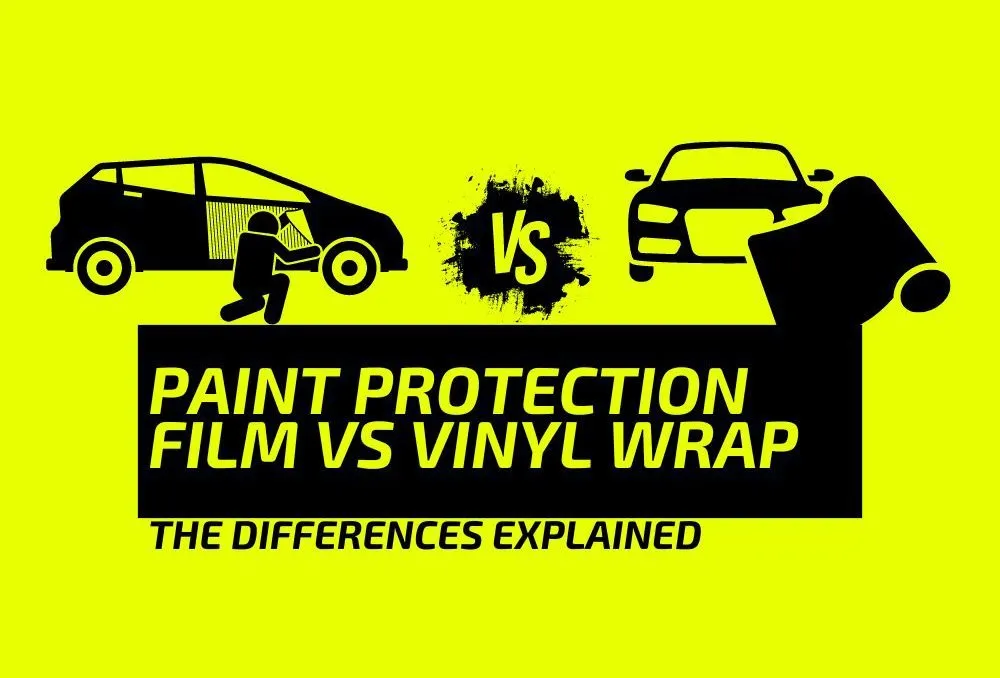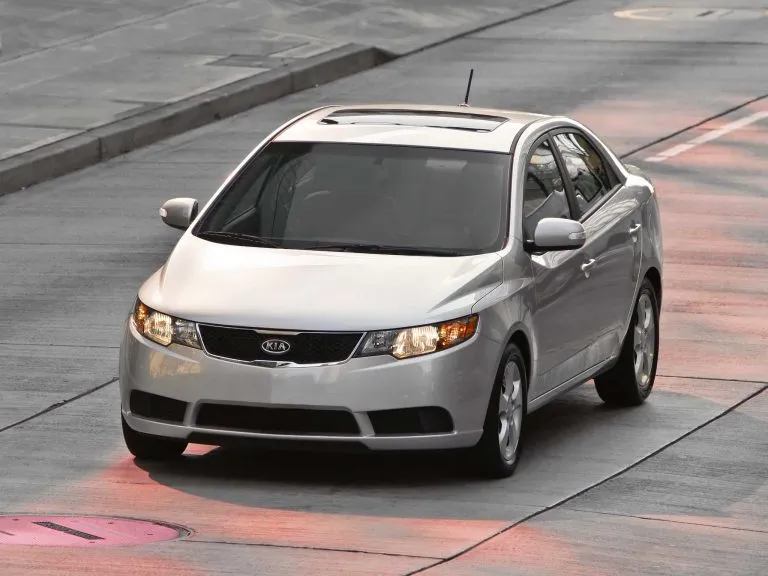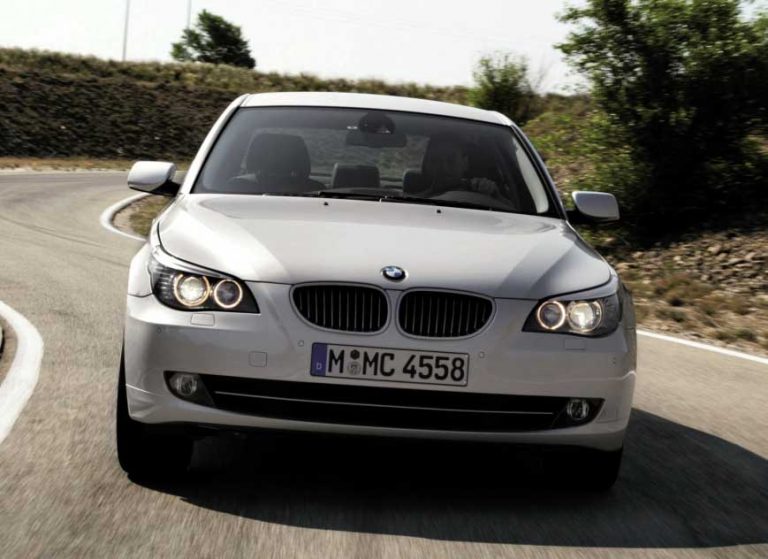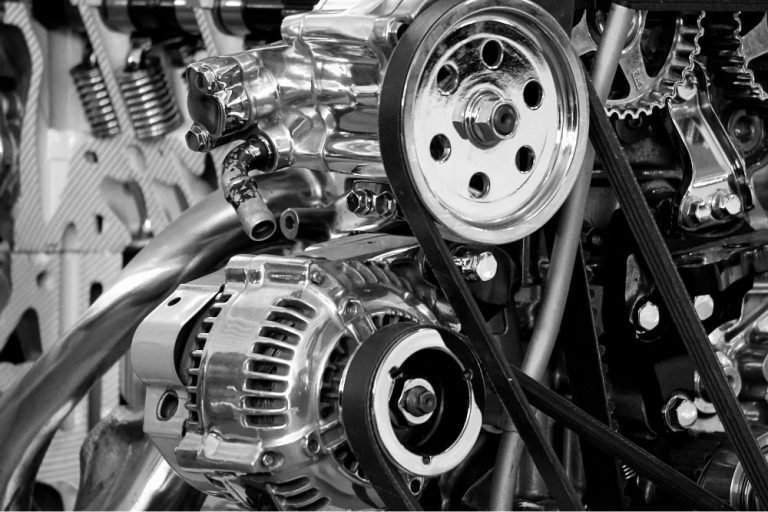Paint Protection Film vs Vinyl Wrap: Key Differences Explained
When you want to either protect your car or completely change its appearance, you have two main options: paint protection film (PPF) or vinyl wrap. Both of these materials serve different purposes, and we’re here to tell you the difference so you can decide what’s best for your needs.
Paint protection film, or PPF, is a transparent, thermoplastic urethane film that acts like a clear coat, shielding your vehicle’s paint from potential damage. This could include rock chips, scratches, bug splatters, bird droppings, and UV rays. So if you’re mainly looking to preserve the beauty of your car’s original paint, PPF might be the better option for you.
On the other hand, vinyl wrap is a versatile material that can change your vehicle’s appearance with a variety of colors and finishes. Unlike PPF, it doesn’t provide the same level of paint protection, but it does offer a cost-effective and reversible option if you want a fresh look for your ride. So, if you’re more interested in customizing the appearance of your car, vinyl film might be your go-to choice.
TLDR Summary
When you want to either protect your car’s paint or change the way your car looks entirely, there are two popular options to compare (PPF) Paint Protection Film vs Vinyl wrap. PPF is a transparent, thick film that shields the paint from scratches, rock chips, and other elements. On the other hand, vinyl wrap serves a dual purpose by offering mild protection while changing the appearance of your vehicle with different colors and designs.
PPF uses wet installation, where the film needs to be wet to adhere to your car’s surface. This process typically involves a mix of soap and water or an installation gel. Conversely, vinyl wrap is installed dry, and any water during the installation process can make it fail.
In terms of durability and thickness, PPF is much thicker than vinyl wrap. PPF usually measures about 6 to 12 mils, while vinyl wrap is around two to four mils. This extra thickness makes PPF more effective at protecting your car from physical damage. But if you want a custom look for your vehicle, vinyl wrap offers more variety and is easier to change or remove.
To sum it all up, here’s the key differences between PPF and vinyl wrap:
- PPF is a clear, thick film that offers better protection against scratches, stone chips, and road debris.
- Vinyl wrap allows for a custom appearance and provides mild protection.
- PPF requires a wet installation, while vinyl wrap is installed dry.
- PPF is significantly thicker than a vinyl wrap.
So, depending on your goals, either PPF or vinyl wrap could be the right choice for you. If protection is your top priority, then PPF is a better option. But if you want to customize your car’s look while offering some basic protection to your car, vinyl wrap might be the way to go.
What Are Paint Protection Film and Vinyl Wrap
Paint Protection Film
Paint protection film (PPF) is a durable, transparent film made of urethane that is designed to shield your car’s paint from various hazards. It prevents damage from things like rock chips, bird droppings, and even UV light. PPF is the perfect choice for those seeking extensive protection, especially for off-road or highway driving.
To give you an idea of how PPF works, imagine a clear, protective shield that adheres to the surface of your car. But don’t worry, it won’t alter your car’s appearance. The installation process typically involves a wet application, mixing soap and water, or an installation gel, which allows the film to adhere smoothly to the surface of your car.
Vinyl Wrap
A vinyl wrap, on the other hand, is a thin layer of material made from polyvinyl chloride (PVC) that adheres to your car’s exterior. Vinyl wraps serve a dual purpose: they can protect your car from minor damages like rock chips and UV light, and they also allow you to customize your car’s appearance.
Installing a vinyl wrap is different from applying PPF. This process is dry, meaning the film is installed without any water or moisture. In fact, any water during the installation can cause the wrap to fail. Vinyl wraps out there in today’s market have an endless amount of colors, patterns, and finishes, which literally allows anyone to express their personal style.
Keep in mind that vinyl wrap is thinner than PPF, so it won’t be as effective at protecting your car from a deep scratch, stone chips, severe damage or scuffs. If you’re mainly looking to change your car’s appearance and provide some level of protection, vinyl wrap might be the path you’d be better suited to over PPF.
Reasons for Choosing Paint Protection Film vs Vinyl Wrap
When car owners want to protect and enhance the appearance of their vehicle, the main options to compare are paint protection film vs vinyl wrap. They both have their positive and negative attributes.
PPF, which is also known as a clear bra wrap, is a thick and transparent film applied to your vehicle’s original paint. The primary purpose of PPF is to safeguard the car’s paint from scratches, rock chips, dust, and other potential damage.
PPF is perfect for off-road or highway driving, where you are more likely to encounter road debris that can damage your car’s paint. Additionally, PPF can provide some protection against UV light, which helps prevent fading of the original paint.
Advantages of PPF:
- Provides extensive protection for your vehicle’s paint
- Protects against deep scratches and scuffs
- Clear and virtually invisible, preserving the original paint color
On the other hand, vinyl wrap is a thin and colorful film used to change the appearance of your vehicle dramatically. Unlike PPF, which is transparent, vinyl wraps come in a ton of colors and finishes (e.g., matte, gloss, metallic, etc.), allowing you to customize your ride depending on the color and type of wrap you choose. Vinyl wrap can protect your vehicle from minor rock chips, bird droppings, and the negative effects of UV light. Although it’s definitely not as effective at preventing deep scratches or scuffs as PPF.
Advantages of Vinyl Wrap:
- Allows for customization of your car’s appearance
- Protects against minor rock chips, dust, and UV light
- Removal is easy and won’t damage the paint underneath
If you want to take your vehicle’s protection up a notch, combining PPF with a ceramic coating product like Ceramic Pro is another option. Ceramic Pro is a nano-ceramic coating that creates a transparent, protective layer on top of your car’s PPF or paint. This layer offers additional protection against UV light, water spotting, and chemical stains from environmental contaminants.
No matter which way you go, either PPF or vinyl wrap, do your own research and ask around to make the best decision for you. Both PPF and vinyl film can help keep your car looking fresh whilst maintaining its value.
Advantages and Disadvantages
Paint Protection Film Advantages and Disadvantages
Paint protection film, or PPF for short, has some fantastic advantages that you might want to consider for your car. One impressive feature is its self-healing properties. If your car suffers from minor scratches, the film can restore itself with a little heat, making it look brand new again. Another great attribute is its stain resistance. Say goodbye to annoying, tough-to-remove stains left by pesky bird droppings or tree sap.
PPF is also adept at blocking UV rays. This means your car’s paint will be protected from fading or changing color over time, helping you maintain its original appearance. And if you sell your car one day, PPF can be cleanly removed, leaving your paint in pristine condition and potentially increasing your resale value if sold with the PPF as it shows you took excellent care of the paint.
But, like anything else, PPF has some disadvantages too. One of the primary drawbacks is cost; PPF installation can be quite expensive. Additionally, the PPF’s thickness may make it a little more challenging to apply to vehicles with complex body shapes or curves, resulting in a longer installation process and higher PPF installation costs.
Vinyl Wrap Advantages and Disadvantages
Vinyl wraps, on the other hand, have their own unique set of benefits. With an array of colors, finishes, and textures, you can truly personalize your car to reflect your style. Cars with vinyl wraps will always stand out in a crowd, especially if you opt for a funky matte finish. Vinyl wraps are also durable, providing protection against minor scratches, stone chips, and UV rays.
However, vinyl wraps might not be the perfect choice for everyone. Although they do offer some protection against those pesky dings and scratches, they don’t have the self-healing properties that PPF possesses. Also, if you opt for vivid colors or unique patterns, be aware that it could potentially hurt your car’s resale value, as buyers may prefer the original paint color.
Vinyl wraps are installed dry, which makes them a bit more forgiving than PPF in terms of application, but they can also be susceptible to damage if water is allowed to seep underneath the wrap during installation. If you decide to go down the vinyl wrap route, it’s essential to have a skilled professional handle the job to avoid any complications.
Difference Between Paint Protection Film vs Vinyl Wrap
Protection and Durability
Paint protection film vs vinyl wrap both have distinct characteristics that cater to different needs. PPF shields your car’s paint job, protecting it from common hazards such as rock chips, bird droppings, and dried tree sap. As the name states, the whole point of PPF is to provide a durable barrier for your vehicle’s exterior.
On the other hand, vinyl wraps focus on transforming the appearance of your car without necessarily offering significant protection. Although they do provide some level of safeguarding, their primary purpose is to change the look of your vehicle with different colors and custom designs.
Ease of Installation
When it comes to installation, there are notable differences between Paint protection film vs vinyl wraps. PPF installation requires a wet method, in which the film must be dampened to adhere to your car’s surface. Typically, a mixture of soap and water or an installation gel is used during this process. Whilst it’s not an easy process, it usually comes pre-cut making PPF installation more straight forward.
Conversely, vinyl wraps are installed using a dry method. Unlike PPF, applying water during vinyl wrap installation can actually hinder your efforts and lead to a failed job. They are also less forgiving when adapting them to different panels, there is a lot of trial and error to get it right. This means that vinyl wraps demand more precision and expertise during the installation process.
Aesthetics
If you’re seeking an entire car makeover, vinyl wraps offer a wide range of options. You can choose from various colors and custom designs to give your vehicle a fresh, unique look. In addition to covering the full body of your car, vinyl wraps can also be applied selectively to specific areas, such as the front bumper or side panels.
PPF, being transparent, doesn’t alter the appearance of your vehicle as significantly as vinyl wraps do. Its purpose is to preserve the existing paint job while providing a protective layer. Although, there is an option to use a Satin/Matte PPF, this will give your original paint a satin/matte finish instead of gloss whilst retaining the cars original color. If aesthetic modifications aren’t your primary concern, paint protection film might be the better option for you.
Common Myths and Misconceptions
Paint Protection Film Myths
There are a few myths surrounding paint protection film (PPF) that may be causing some confusion. One myth is that PPF can’t be waxed or have ceramic coating applied, leaving your car difficult to maintain. This is not true. The reason for this belief is that people often confuse PPFs with aesthetic vinyl car wraps, which are used to create different looks like matte, metallic, or chrome finishes.
Another misconception is that PPF is simply a clear version of a vinyl wrap. The truth is PPF, and vinyl wraps are entirely different in function, material, and installation. PPF is solely designed to protect your paint from damage, while vinyl wraps are primarily for altering the appearance of your vehicle in a quick and cost-effective way.
Vinyl Wrap Myths
On the subject of myths, there are a few misconceptions with vinyl wraps to clear up. One common myth is that vinyl wraps provide the same level of protection as PPF. While it’s true that vinyl wraps can protect your vehicle from minor rock chips, bird droppings, and UV light, they are not as effective as PPF in offering extensive protection from deep scratches or scuffs due to being thinner than PPF.
Another myth is that the installation process of vinyl wraps and PPF is the same. In reality, they’re installed differently. As previously mentioned a few times, PPF uses a wet installation method, where the film needs to be wet to adhere to your car’s surface. On the other hand, vinyl wraps are installed dry, and the presence of water during the installation process can actually cause the wrap job to fail.
Understanding the Application Process
Paint Protection Film
When applying paint protection film (PPF), the process involves a few key steps. First, it’s essential to ensure the car’s surface is free of any debris, so a thorough wash and possibly a clay bar treatment are necessary. Next, any pre-existing damage, such as paint chips or scratches, should be addressed before the film’s application.
PPF installation requires a wet method, meaning the film and the car surface need to be wet to allow it to adhere correctly. A skilled installer will carefully position the clear film on your vehicle, making sure to avoid any air bubbles or wrinkles. PPF typically comes with a 10-year warranty, which speaks to its durability and value.
Vinyl Wrap
On the other hand, the vinyl wrap application process is quite different. Like PPF, your car must be clean and free of debris. But unlike PPF, vinyl wrap installation uses a dry method, as any water during the process can cause the wrap job to fail.
The base material of a vinyl wrap is more customizable, offering a variety of colors, textures, and finishes for a unique look. Professional installers with experience in vinyl wraps will meticulously apply the wrap, ensuring that each panel lines up perfectly and any seams are well-hidden.
Remember, each method has its own benefits and drawbacks, but understanding the application process for both paint protection film and vinyl wrap will help you make an informed decision for your vehicle’s needs.
Choosing the Best Option for Your Vehicle
When it comes to deciding between paint protection film (PPF) and vinyl wrap for your vehicle, both options have advantages and drawbacks, so knowing what each offers will help you make the best choice for your car.
PPF is a thicker material that provides better protection against deep scratches and scuffs, making it the better option if you love the way your car looks already and do a lot of highway driving or have a special car you just want to protect in any scenario. It guards your car’s paint from rock chips, dried tree sap, and bird droppings, ensuring that your vehicle remains in top condition. Since PPF is transparent, it doesn’t alter your car’s appearance while providing excellent protection.
On the other hand, vinyl wraps are thinner materials, offering protection against minor rock chips, bird droppings, and UV light degradation. The main advantage of vinyl wrap is transforming the color of your car, giving you the freedom to create a completely new appearance without breaking the bank. Vinyl wraps tend to be less expensive than PPF, making them a popular choice for those looking to change their car’s look while still offering some protection.
Here are the key differences:
| Features | Paint Protection Film | Vinyl Wrap |
|---|---|---|
| Thickness | Thicker | Thinner |
| Cost | Usually more expensive | Less expensive (around half the price of PPF) |
| Installation | Wet installation using soap and water or gel | Dry installation (water-free) |
| Protection Level | Better protection against deep scratches and scuffs | Protection against minor rock chips, bird droppings, and UV light |
| Appearance Changes | None (Unless Satin/Matte Finish) | Can change color and design of vehicle |
Additional Protection and Care
Ceramic Coating
If you want even more protection, a ceramic coating is an option worth considering, it adds an extra layer that bonds to your vehicle’s paint surface, providing a protective layer against environmental hazards. It shields your car from harmful UV rays and can make it more resistant to scratches and minor scuffs. Plus, it adds an extra shine, so you can enjoy an even better looking ride.
When applied over paint protection film or vinyl wrap, ceramic coating can actually prolong their lifespan. Meaning it will extend the longevity of your wrap and be protected for even longer. Remember, ceramic coating isn’t a substitute for paint protection film or vinyl wrap but an additional way to enhance your car’s appearance and give it some extra protection.
Paint Correction
Paint correction is a process of removing defects, like swirl marks or scratches, from your car’s paint surface. It involves using various techniques such as polishing, compounding, and sanding to restore your vehicle’s original shine. If you have paint protection film on your car, paint correction can help enhance its appearance by fixing any issues that might have popped up over time, prior to installing the PPF on your car.
Here’s a few tips for taking care of your paint protection film or vinyl wrap:
- Wash your car regularly using a gentle car wash soap.
- Avoid harsh chemicals or anything rough on the surface, as they can damage the film or wrap.
- Consider applying a sealant or ceramic coating to maintain the film/wrap’s lifespan.
- Inspect the film or wrap regularly to find and prevent further issues.
By following these tips and including ceramic coating and paint correction, you will not only protect your car’s paint surface but also maintain its stunning appearance.
Top Brands and Products
Paint Protection Film Brands
One of the top PPF brands on the market today is XPEL. Their Ultimate series provides high-quality materials designed to keep your car looking its best. The Ultimate PPF is warranted for ten years after installation, ensuring long-lasting durability and protection.
Another prominent brand of paint protection film is 3M. Their Scotchgard Pro line offers a 10-year warranty after installation. The 3M Scotchgard Pro proves itself to be a reliable choice for keeping your vehicle in pristine condition.
LLumar’s Platinum series is an exceptional PPF option. It is warranted for ten years after installation, giving your car a high level of performance and protection throughout its lifespan.
Vinyl Wrap Brands
Avery Dennison is a leading brand in the vinyl wrap industry. Recognized for their versatile selection of colors and finishes, they enable you to customize your car’s appearance while providing UV protection and scratch resistance. Keep in mind vinyl wraps usually last around 2-3 years in sunny climates like Florida and require more maintenance than PPF.
3M vinyl wraps feature a huge range of colors and are at the forefront of the wrapping industry. Through their extensive experience, the 3M line of vinyl wraps not only give your car a fresh, unique appearance but also help in safeguarding its paint job.
A relatively newer brand the hit the market is Inozetek, they offer some of the highest quality wraps and people say they’re more affordable, I’m yet to determine how much more affordable they are, but it still won’t be considered cheap. Regardless, they offer some of the most stunning colors and have really made an impact on the aftermarket car industry.
Remember, each of these different products has its pros and cons. When choosing between paint protection film or vinyl wrap, it’s essential to prioritize what you value most. If long-lasting protection is your main concern, PPF might be the better option. But if you’re looking to transform your car’s look and personality, vinyl wraps will dazzle with their customizable colors and finishes.
Wrap Up!
If you want to protect your paint or change your cars look entirely, you either go with paint protection film (PPF) or vinyl wrap. PPF is designed primarily for protection against damage, such as rock chips and scratches, and it usually has a longer lifespan of 5-10 years. Vinyl wrap, on the other hand, serves both aesthetic and protective purposes and lasts around 2-7 years.
The installation process of these two products is quite different. PPF requires a wet installation, meanwhile, vinyl wrap is installed dry, and water during the installation can cause the wrap to fail.
When choosing between the two, focus on the primary goal for your car. If protection against physical damage is your main concern, PPF might be the better choice for you. Otherwise, if you want to customize the appearance of your car while gaining some protection, a vinyl wrap could be a suitable option.
Take your time to research both options and consult with professionals before making a decision. This will supplement what we’ve told you, plus give you a full perspective on the best protection and the look you desire without any unnecessary hassles. Happy driving!
Frequently Asked Questions
Below are a list of frequently asked questions on paint protection film vs vinyl wrap:
What is the difference between paint protection film (PPF) and vinyl wrap?
PPF is a thick, clear film that protects your car’s paint from scratches, rock chips, and other hazards. Vinyl wrap is a thinner, colored, or patterned film that changes the appearance of your car and offers some protection against minor damage.
Does PPF or Vinyl Wrap offer better protection?
While both PPF and vinyl wrap provides some protection for your car’s paint, PPF is generally better for extensive protection due to its thicker material. PPF is particularly well-suited for off-road or highway driving, where your car is more likely to encounter hazards.
Does PPF look better than Vinyl wrap?
This is all personal preference. PPF is clear and maintains the original look of your car’s paint, while vinyl wrap comes in various colors and designs that can completely change the appearance of your car. Consider your aesthetic goals when choosing between the two.
What is the lifespan of PPF and vinyl wrap?
PPF typically lasts between 5 to 10 years, but we have to state this depends on the quality of the installation and the film. Vinyl wraps have a shorter lifespan that varies from 3 to 5 years. Longevity for both depends on the environment they’re kept in as well, for example parked in a garage vs on the street in direct sunlight 24/7.
Which one is easier to install?
Both PPF and vinyl wrap requires a skilled professional for a successful installation. However, due to the thickness of PPF, it can be slightly more challenging to install compared to vinyl which is generally more forgiving. Yet, it is essential to find an experienced installer for both options to ensure a high-quality, long-lasting result.
How do these options compare in terms of cost?
Vinyl wraps tend to be more affordable than PPF, with prices varying depending on the size of your car and how complex the design is. PPF, being a more durable and protective option, can be a bit more costly. Remember that it’s important to weigh your budget against the protection and appearance you desire for your car.







